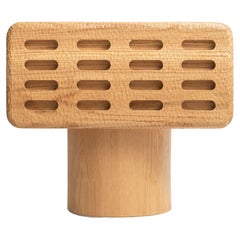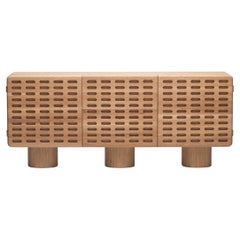Codice Side Table
2010s Guatemalan Modern Side Tables
Oak, Bentwood
2010s Guatemalan Modern Side Tables
Oak, Bentwood
People Also Browsed
2010s American Dining Room Chairs
Walnut, Ash, Maple, Oak
2010s American Modern Table Lamps
Ceramic
2010s Philippine Mid-Century Modern Wall Mirrors
Rattan, Glass
2010s American Modern Side Tables
Steel, Iron
2010s Mexican Modern Armchairs
Upholstery, Hardwood
21st Century and Contemporary American American Classical Wall Lights an...
Brass
2010s Console Tables
Travertine
21st Century and Contemporary French Side Tables
Concrete, Steel
21st Century and Contemporary French Brutalist Night Stands
Oak
2010s European Organic Modern Console Tables
Stone, Travertine, Marble
2010s Vietnamese Scandinavian Modern Desks and Writing Tables
Burl
21st Century and Contemporary Italian Modern Sideboards
Steel
21st Century and Contemporary Italian Mid-Century Modern Chandeliers and...
Brass
2010s European Mid-Century Modern Wall Lights and Sconces
Brass
2010s Indian Modern Wall Lights and Sconces
Brass
21st Century and Contemporary Portuguese Armchairs
Marble
A Close Look at Modern Furniture
The late 19th and early 20th centuries saw sweeping social change and major scientific advances — both of which contributed to a new aesthetic: modernism. Rejecting the rigidity of Victorian artistic conventions, modernists sought a new means of expression. References to the natural world and ornate classical embellishments gave way to the sleek simplicity of the Machine Age. Architect Philip Johnson characterized the hallmarks of modernism as “machine-like simplicity, smoothness or surface [and] avoidance of ornament.”
Early practitioners of modernist design include the De Stijl (“The Style”) group, founded in the Netherlands in 1917, and the Bauhaus School, founded two years later in Germany.
Followers of both groups produced sleek, spare designs — many of which became icons of daily life in the 20th century. The modernists rejected both natural and historical references and relied primarily on industrial materials such as metal, glass, plywood, and, later, plastics. While Bauhaus principals Marcel Breuer and Ludwig Mies van der Rohe created furniture from mass-produced, chrome-plated steel, American visionaries like Charles and Ray Eames worked in materials as novel as molded plywood and fiberglass. Today, Breuer’s Wassily chair, Mies van der Rohe’s Barcelona chair — crafted with his romantic partner, designer Lilly Reich — and the Eames lounge chair are emblems of progressive design and vintage originals are prized cornerstones of collections.
It’s difficult to overstate the influence that modernism continues to wield over designers and architects — and equally difficult to overstate how revolutionary it was when it first appeared a century ago. But because modernist furniture designs are so simple, they can blend in seamlessly with just about any type of décor. Don’t overlook them.
Materials: Bentwood Furniture
Antique, new and vintage bentwood furniture has become very popular in interiors over the years. Today bentwood chairs, tables, sofas and pendants are receiving striking modern interpretations from makers like Thonet, which are being carried on by the next generation.
Bentwood furniture dates as far back as the Middle Ages, but it is the 19th-century German-Austrian cabinetmaker Michael Thonet who is most often associated with this now-classic technique. Thonet in 1856 patented a method for bending solid wood through the use of steam, and from there the bentwood look skyrocketed to furniture fame. Bentwood was embraced by design greats ranging from Josef Hoffmann to Gio Ponti, and Adolf Loos to Alvar Aalto for its versatility, timelessness and simple elegance.
In the Czech Republic — home to a range of talented but unsung mid-century modern and Art Deco designers — the company TON held a bentwood furniture exhibition in Ludwig Mies van der Rohe’s Villa Tugendhat in recent years. TON manufactures their bentwood furniture in the same workshops where Michael Thonet set up his operations in the 1800s.
Sophisticated bentwood furniture designs include Alvar Aalto’s cantilever lounge chairs, Italian designer Luigi Crassevig’s 1970s rocking chairs — which feature cane seats — curvaceous hanging lamps and other lighting by Spanish architect José Antonio Coderch and lots more.
Find a collection of antique, new and vintage bentwood furniture on 1stDibs.
Finding the Right Side-tables for You
While the range of styles and variety of materials have broadened over time, the priceless functionality of side tables has held true.
Antique and vintage side tables are an integral accent to our seating and provide additional, necessary storage in our homes. They can be a great foundation for that perfect focal piece of art that you want all your guests to see as you congregate for cocktails in the living room. Side tables are indeed ideal as a stage for your decorative objects or plants in your library or your study, and they are a practical space for the novel or stack of design magazines you keep close to your sofa.
Sure, owning a pair of side tables isn’t as imperative as having a coffee table in the common area, though most of us would struggle without them. Those made of metal, stone or wood are frequently featured in stylish interiors, and if you’re shopping for side tables, there are a couple of things to keep in mind.
With respect to the height of your side tables, a table that is as high as your lounge chair or the arm of your couch is best.
Some folks are understandably fussy about coherence in a living room area, but coherence doesn’t necessarily mean you can’t mix and match. Feel free to introduce minimalist mid-century modern wooden side tables designed by Paul McCobb alongside your contemporary metal coffee table. If you think it isn’t possible to pair a Hollywood Regency–style side table with a contemporary sofa, we’re here to tell you that it is. Even a leggy side table can balance a chunky sofa well. Try to keep a limited color palette in mind if you’re planning on mixing furniture styles and materials, and don’t be afraid to add a piece of abstract art to shake things up.
As far as the objects you’re planning to place on your side tables, if you have heavy items such as stone or sculptures to display, a fragile glass-top table would not be an ideal choice. Think about what material would best support your collectibles and go with that. If it’s a particularly small side table, along with a tall, sleek floor lamp, it can make for a great way to fill a corner of the room you wouldn’t otherwise easily be able to populate.
Whether you are looking for an antique 19th-century carved oak side table or a vintage rattan side table (because rattan never went away!), the collection on 1stDibs has you covered — find Art Deco side tables, bamboo side tables, travertine side tables and more today.

